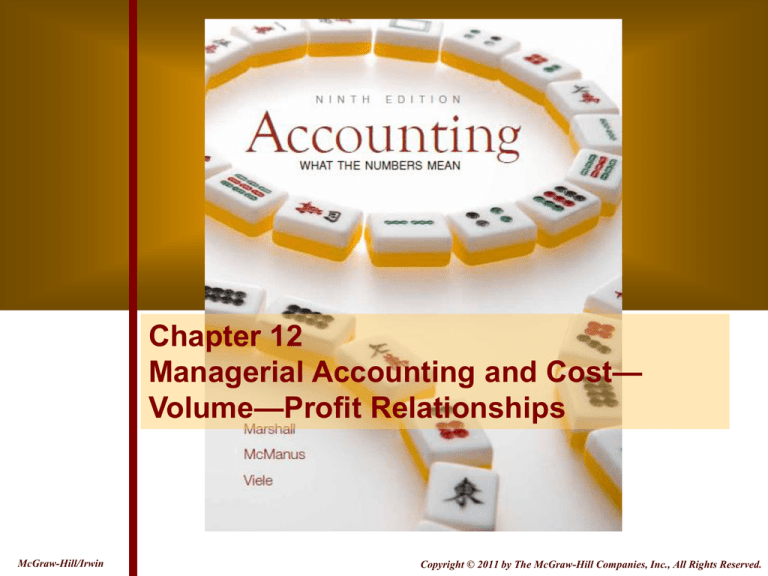
1-1
© 2008 The McGraw-Hill Companies, Inc., All Rights Reserved.
Chapter 12
Managerial Accounting and Cost—
Volume—Profit Relationships
McGraw-Hill/Irwin
McGraw-Hill/Irwin
12-1
© 2008
The ©
McGraw-Hill
Companies,
Inc., All
Reserved.
Copyright
2011 by The McGraw-Hill
Companies,
Inc.,Rights
All Rights
Reserved.
1-2
Decision Making
Revisit Plans
LO1
Performance
analysis:
Plans vs.
actual results
(Controlling)
McGraw-Hill/Irwin
Strategic,
Operational,
and Financial
(Planning)
Implement Plans
Planning and Control Cycle
Data collection and Performance Feedback
Executing
operational
activities
(Managing)
12-2
© 2008 The McGraw-Hill Companies, Inc., All Rights Reserved.
1-3
LO2
Managerial Accounting versus
Financial Accounting
Managerial
Accounting
Financial
Accounting
Internal to managers
External to investors
and creditors
Present and Future
Historical perspective
Micro - Individual units
of organization
Macro - Entire organization
Reporting frequency
and promptness
Frequent and timely one day after period ends
Monthly - a week or
more after period ends
Degree of precision
Relevance more important
than reliability
High accuracy desired reliability very important
None imposed
Must follow GAAP
and prescribed formats
Service perspective
Time Frame
Breadth of concern
Reporting standards
McGraw-Hill/Irwin
12-3
© 2008 The McGraw-Hill Companies, Inc., All Rights Reserved.
1-4
Relationship of Total Cost
to Volume of Activity
LO3
How a cost will react to
changes in the level of
business activity.
– Total variable costs
change when activity
changes.
– Total fixed costs
remain unchanged
when activity changes.
McGraw-Hill/Irwin
12-4
© 2008 The McGraw-Hill Companies, Inc., All Rights Reserved.
1-5
Total Fixed Cost
LO4
Monthly Basic
Telephone Bill
Your monthly basic telephone bill
probably does not change when
you make more local calls.
Number of Local Calls
McGraw-Hill/Irwin
12-5
© 2008 The McGraw-Hill Companies, Inc., All Rights Reserved.
1-6
Fixed Cost per Unit
LO4
Monthly Basic Telephone
Bill per Local Call
The average cost per local call decreases
as more local calls are made.
Number of Local Calls
McGraw-Hill/Irwin
12-6
© 2008 The McGraw-Hill Companies, Inc., All Rights Reserved.
1-7
Total Variable Cost
LO5
Total Long Distance
Telephone Bill
Your total long distance telephone bill
is based on how many minutes you talk.
Minutes Talked
McGraw-Hill/Irwin
12-7
© 2008 The McGraw-Hill Companies, Inc., All Rights Reserved.
1-8
LO5
Variable Cost Per Unit
Per Minute
Telephone Charge
The cost per long distance minute talked
is constant. For example, $0.10 per minute.
Minutes Talked
McGraw-Hill/Irwin
12-8
© 2008 The McGraw-Hill Companies, Inc., All Rights Reserved.
1-9
LO6
The High-low Method
High activity level
Low activity level
Change
Cost
$ 9,700
(6,100)
$ 3,600
Units
9,000
(5,000)
4,000
Unit variable cost = $3,600 ÷ 4,000 units = $0.90 per unit
Fixed cost = Total cost – Total variable cost
Fixed cost = $9,700 – ($0.90 per unit × 9,000 units)
Fixed cost = $9,700 – $8,100 = $1,600
Total cost = Fixed cost + Variable cost (Y = a + bX)
Y = $1,600 + $0.90X
McGraw-Hill/Irwin
12-9
© 2008 The McGraw-Hill Companies, Inc., All Rights Reserved.
1-10
LO7
The Contribution Margin Format
Used primarily for
external reporting.
Used primarily by
management.
Both formats report the same operating income!
McGraw-Hill/Irwin
12-10
© 2008 The McGraw-Hill Companies, Inc., All Rights Reserved.
1-11
LO9
The Contribution Margin Format
Contribution margin ratio
McGraw-Hill/Irwin
12-11
© 2008 The McGraw-Hill Companies, Inc., All Rights Reserved.
1-12
Multiple Products and
Sales Mix Considerations
L O 10
Sales mix is the relative combination in which
a company’s different products are sold.
Different products have different selling
prices, costs, and contribution margins.
A change in the sales mix will result in a
different contribution margin ratio.
McGraw-Hill/Irwin
12-12
© 2008 The McGraw-Hill Companies, Inc., All Rights Reserved.
1-13
Multiple Products and
Sales Mix Considerations
L O 10
How will average total contribution margin change if Jones sold 1,500
lawn tractors, all other factors held constant?
Lawnmowers
Sales
$ 250,000 100%
Variable expense
150,000
60%
Contribution margin $ 100,000
40%
Fixed expense
Operating income
Lawn tractors
$450,000 100%
202,500
45%
$247,500
55%
Total
$ 700,000 100%
352,500 50%
$ 347,500 50%
170,000
$ 177,500
Average total contribution margin ratio provided from all products:
$347,500
$700,000 = 50%
Increases
(rounded)
Due to selling
more product with a higher CM ratio.
McGraw-Hill/Irwin
12-13
© 2008 The McGraw-Hill Companies, Inc., All Rights Reserved.
1-14
L O 11
Break-Even Point Analysis
How many units must Evans sell to
cover its fixed costs (break even)?
Answer: $30,000 ÷ $4 per unit = 7,500 units
McGraw-Hill/Irwin
12-14
© 2008 The McGraw-Hill Companies, Inc., All Rights Reserved.
1-15
L O 11
Break-Even Point Analysis
The break-even formula may also be
expressed in sales dollars.
Break-even point in dollars =
Fixed costs
Contribution margin ratio
Unit sales price
Unit variable cost
McGraw-Hill/Irwin
12-15
© 2008 The McGraw-Hill Companies, Inc., All Rights Reserved.
1-16
L O 11
Break-Even Point Analysis
Break-even formulas may be adjusted to
show the sales volume needed to earn
any amount of operating income.
Unit sales =
Fixed costs + Desired income
Contribution margin per unit
Fixed costs + Desired income
Dollar sales =
Contribution margin ratio
McGraw-Hill/Irwin
12-16
© 2008 The McGraw-Hill Companies, Inc., All Rights Reserved.





